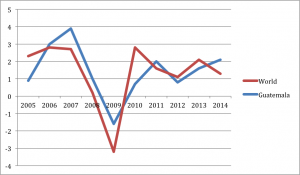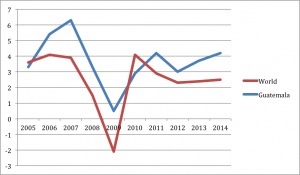 Perhaps no single statistic is more indicative of a country’s economic standing than that of GDP. Gross Domestic Product officially tells us the market value of all goods and services produced in a country in a given time period, minus the value of the goods and services used in the process of production. Essentially, that’s a wordy definition for a metric that tell us how well a country is doing economically.
Perhaps no single statistic is more indicative of a country’s economic standing than that of GDP. Gross Domestic Product officially tells us the market value of all goods and services produced in a country in a given time period, minus the value of the goods and services used in the process of production. Essentially, that’s a wordy definition for a metric that tell us how well a country is doing economically.
For a country plagued by civil war, natural disasters and poor economic policy, it comes as no surprise that Guatemala has historically had a relatively low GDP, much like most of its Central American neighbors. A country with 50% of its population below the poverty line is unlikely to produce a GDP worth boasting about anytime soon, but there is reason to believe that perhaps Guatemala’s current GDP of $126B (in purchasing power parity), good for 80th in the world, may be better than it looks.
Among those goods and services that do not count towards GDP are those made and consumed within the home, which never enter the marketplace. Guatemala presently is only 50% urbanized, leaving half its population in rural areas far from large markets. What this means of course, is that many of these families are farmers who are creating goods and providing services daily, but for themselves. So while that hard work won’t show up in Guatemala’s GDP, it is not a reflection of the level of work Guatemalans are producing.
The good news for those itching to see Guatemala’s GDP increase, is that despite having Central America’s lowest urbanized population percentage, the urbanized population is growing at a rate of 3%, far outpacing the majority of the world, the average of which is at 2%. Why is this good? The more people there are in urbanized areas, the more likely they are to buy and sell goods (as opposed to simply farming for oneself), which of course contributes to GDP. Guatemala’s GDP is currently comprised of 63% services, 24% industry and 13% agriculture, despite 38% of the workforce working in agriculture, 48% in services and just 14% in industry. This means that services and industry are much more lucrative fields than agriculture, and a more urbanized population should translate to more people in services and industry, which in turn should bolster GDP growth.
What seems to back this up is the chart below showing Guatemala’s GDP growth percentage compared to that of the rest of the world’s. Although Guatemala took slightly longer than the average of the rest of the world to initially get out of the recession in 2010, at avery other point in the last decade it has led the world (currently at 4.2% growth compared to the world’s 2.7%), an undeniably positive sign for the country.
Unfortunately, when provided the appropriate context, Guatemala may not be in as great shape as it initially appeared. While Guatemala’s overall GDP growth is a reason for hope, it’s GDP per capita is a measly $7,900, good for just 149th in the world. As the chart below shows, Guatemala’s GDP growth percentage per capita is more or less in lockstep with that of the rest of the world, neither leading nor lagging for more than a year since the recession.
 GDP Growth Percentage Per Capita
GDP Growth Percentage Per Capita
Pair that with a 2.3% deficit (as a percentage of GDP), and a public debt of over 30% of GDP (141st in the world), and suddenly the Guatemalan outlook is not quite as rosy as initially believed.
So what does it all mean for Finagle A Bagel? Frankly, it’s unclear. Obviously, the higher a country’s GDP the better for a company trying to sell goods in that country. That being said, GDP is far less relevant to an extremely low-cost good such as a bagel, compared to luxury items such as cars or electronics, for example. While we will continue to stay apprised of the GDP in Guatemala, the population becoming increasingly urbanized is currently more important to our company than the fact that GDP growth per capita is suboptimal at the moment. Learn about Guatemala’s unemployment levels, and how they effect GDP here.

Guatemala isn’t rich with natural resources. I think it become another problem. What do you think?